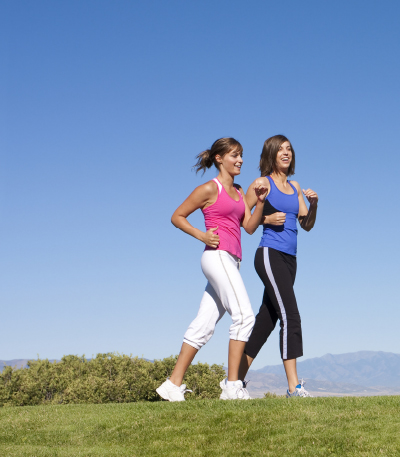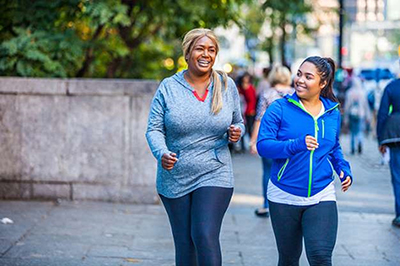A STEP IN THE RIGHT DIRECTION
Walk Your Way To Fitness
By Patricia Canole
Most New Yorkers may think they’re experts when it comes to walking. After all, we are known as the best city for walking. But besides getting from Point A to Point B, walking is the best heart-healthy exercise going.
Here, short advice on long-term benefits. With season temps rising, it’s perfect for trying one or all on your next stroll around town.

TRIM YOUR WAISTLINE
Lack of exercise and sitting around and not moving? No one is immune from adding those pandemic pounds. If you’ve noticed an increasing midriff bulge, a regular daily brisk walk can help get you back in shape. With a steady regular walking schedule, you will have flatter abs in no time. The critical thing to remember is your technique for walking should be correct. Hold your head up, looking straight ahead, not at the ground. Keep your neck, shoulders, and back relaxed. Walking with stiffness will be very tiring and leave you sore afterward. Breathe deeply as you walk and enjoy nature’s beauty and what’s around you.
REDUCE STIFF JOINTS
If you walk for 30 to 60 minutes every day, you will get the best natural arthritis pain relief. Walking helps reduce inflammation and stiffness in your joints. When you first start, go at a slower pace and gradually build up to walking faster and longer. You will feel great.
MANAGE YOUR BP
It has been reported that a daily walk can lower blood pressure naturally. Many of us may claim we don’t have time to do 30- or 45-minute walks each day. Good news! Studies now show that several 10-minute brisk walks can be as helpful as one long walk. Walk in the morning for 10 minutes; take a 10-minute stroll at lunchtime, and then again in the evening.
A STRESS-BUSTER
Mental stress is a problem for most of us these days. Because there are so many things to deal with, is it any wonder you may feel distracted. Take a break from what you are doing. Research shows that a brisk 20- to 30-minute walk every day can reduce mental stress. It is said to have the same effect as a mild tranquilizer.
CUT BREAST CANCER RISKS
Walking, even for a few hours a week, significantly reduces the risk of developing breast cancer. According to the Journal of the American Medical Association, walking helps lower body fat levels, a source of estrogen. The research looked at seven post-menopausal women and found those at a healthy weight lowered their risk by 30 percent while those who were overweight, by 10 to 20 percent.
BETTER SLEEP
According to the National Sleep Foundation, a brisk walk will help you get a better night’s sleep. Walking boosts levels of the feel-good hormone serotonin, which relaxes you. The rise in body heat brought on by walking may, in turn, signal the brain to lower your temperature later, which promotes sleep.

PROTECT BONES
Just 30 minutes of walking three times a week will do wonders for your bones. This type of exercise, which uses 95 percent of your muscles, push your bones to become stronger so they can handle the load. Walking is not just for cardio.
LIVE LONGER
Studies show that daily walks will extend your life as well as make you feel better. There are so many benefits to walking that it can’t help but extend and improve your life. You will be able to move more freely for a lot longer.

You may have heard you need to aim for 10,000 steps each day to get fit. But how did this originate? It all began in Japan during the 1960s, when Yoshiro Hatano, Ph.D., tracked habitually active walkers.
His team determined that the average man burned 300 calories by approximately walking 10,000 steps. And so manpo-kei (“10,000 steps meter”) was born, otherwise known as the pedometer. Of course, most of us use an app on our phones which is even more convenient.
Today, most experts agree the number is a bit arbitrary. Nevertheless, counting steps is essential. Keep in mind the number of steps depends on your aim. The rule of thumb: Walk as much as you can whenever you can. You know it has health benefits—so why not just do it?



By now, you realize that walking is good for your heart, burns calories, and helps you stay young. Here’s how to make it fun and part of your daily routine.
- Arm Yourself Borrow this simple move from Olympic champions. Bend arms to 90-degree angles and swing them as you walk. Correct arm positioning plays a vital role in how fast you walk, and the quicker you walk, the more calories you burn.
- Walk A Hound, Lose A Pound Studies show that walking a pet dog is beneficial to your health (and your pet, too!) No pet? Then volunteer to walk dogs at an animal shelter! Doing this daily routine not only alleviates depression but trims your waistline as well.
- Mix It Up Alternating short stints of fast walking and medium-recovery periods is a wonderful way to burn calories without adding time to your workout. Try the “talk test” to judge your effort: during the short bouts of fast walking, talking should be challenging; more comfortable during recovery. Alternating short stints of fast walking and medium-recovery periods is a wonderful way to burn calories without adding time to your workout. Try the “talk test” to judge your effort: during the short bouts of fast walking, talking should be challenging; more comfortable during recovery.





